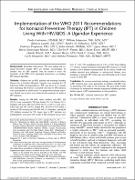| dc.contributor.author | Costenaro, Paola | |
| dc.contributor.author | Massavon, William | |
| dc.contributor.author | Lundin, Rebecca | |
| dc.contributor.author | Nabachwa, M. Sandra | |
| dc.contributor.author | Fregonese, Federica | |
| dc.contributor.author | Morelli, Erika | |
| dc.contributor.author | Alowo, Agnes | |
| dc.contributor.author | Musoke, Nannyonga Maria | |
| dc.contributor.author | Namisi, Charles | |
| dc.contributor.author | Kizito, Susan | |
| dc.contributor.author | Bilardi, Davide | |
| dc.contributor.author | Mazza, Antonio | |
| dc.contributor.author | Cotton, F. Mark | |
| dc.contributor.author | Giaquinto, Carlo | |
| dc.contributor.author | Penazzato, Martina | |
| dc.date.accessioned | 2021-05-06T07:29:35Z | |
| dc.date.available | 2021-05-06T07:29:35Z | |
| dc.date.issued | 2016 | |
| dc.identifier.citation | Costenaro, P., Massavon, W., Lundin, R., Nabachwa, S.M., Fregonese, F., Morelli, E., Alowo, A., Musoke, M.N., Namisi, C.P., Kizito, S. and Bilardi, D., 2016. Implementation of the WHO 2011 Recommendations for Isoniazid Preventive Therapy (IPT) in Children Living With HIV/AIDS: A Ugandan Experience. JAIDS-JOURNAL OF ACQUIRED IMMUNE DEFICIENCY SYNDROMES, 71(1), pp.E1-E8. | en_US |
| dc.identifier.issn | 1525-4135 | |
| dc.identifier.issn | 1077-9450 | |
| dc.identifier.uri | http://hdl.handle.net/20.500.12280/2820 | |
| dc.description.abstract | Background: Intensified tuberculosis (TB) case finding and isoniazid preventive therapy (IPT) are strongly recommended for
children who are HIV infected. Data are needed to assess the feasibility of the WHO 2011 intensified tuberculosis case finding/
IPT clinical algorithm.
Methods: Children who are HIV infected and attending Nsambya Home Care at Nsambya Hospital, Uganda, were screened for TB following WHO recommendations. IPT was given for 6 months after excluding TB. Factors associated with time to IPT initiation
were investigated by multivariate Cox proportional hazard regression. Health care workers were interviewed on reasons for delay in IPT initiation.
Results: Among the 899 (49% male) children with HIV, 529 (58.8%) were screened for TB from January 2011 to February 2013.
Children with active TB were 36/529 (6.8%), 24 (4.5%) were lost to follow-ups and 280 (52.9%) started IPT, 86/280 (30.7%) within 3 months of TB screening and 194/280 (69.3%) thereafter. Among the 529 children screened for TB, longer time to IPT initiation was independently associated with cough at TB screening (hazard ratio 0.62, P = 0.02, 95% confidence interval: 0.41 to 0.94). Four children (1% of those starting treatments) interrupted IPT because of a 5-fold increase in liver function measurements. In the survey, Health care workers reported poor adherence to antiretroviral therapy, poor attendance to periodic HIV follow-ups, and pill burden as the 3 main reasons to delay IPT.
Conclusion: In resource-constrained settings, considerable delays in IPT initiation may occur, particularly in children with HIV who
are presenting with cough at TB screening. The good safety profile of isoniazid in antiretroviral–therapy-experienced children provides further support to IPT implementation in this population. | en_US |
| dc.language.iso | en | en_US |
| dc.publisher | LIPPINCOTT WILLIAMS & WILKINS , TWO COMMERCE SQ, 2001 MARKET ST, PHILADELPHIA, USA, PA, 19103 | en_US |
| dc.relation.ispartofseries | JAIDS- Journal of Acquired Immune Deficiency Syndromes;71(1) | |
| dc.subject | IPT | en_US |
| dc.subject | Isoniazid | en_US |
| dc.subject | Tuberculosis | en_US |
| dc.subject | HIV | en_US |
| dc.subject | Children | en_US |
| dc.title | Implementation of the WHO 2011 Recommendations for Isoniazid Preventive Therapy (IPT) in Children Living With HIV/AIDS: A Ugandan Experience | en_US |
| dc.type | Article | en_US |


